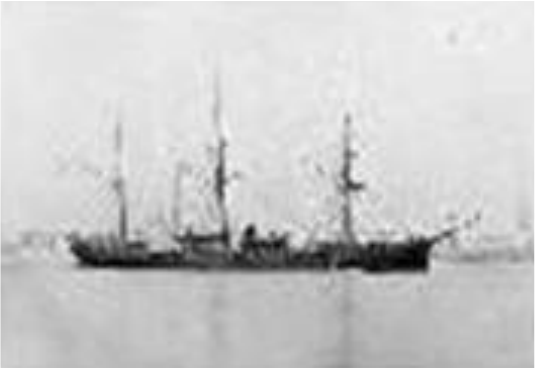The Ticonderoga's Haunted Blue Bell with the Bewitching Tone
 The Ticonderoga
United States Naval Historical Society
The Ticonderoga
United States Naval Historical Society
The spirits always ring the watch bell nine times instead of eight. In the middle of the deep sea nights when the moon rides the sky like a ghostly galleon, the haunted blue watch bell on the Ticonderoga once again chimes nine times.
The haunted bell blue bell, the one that sailors claimed had the best tone in the Navy, earned the Ticonderoga the reputation for being a “haunted ship” everywhere it sailed. Sailors would not stay aboard the Ticonderoga and some blamed its decommissioning on the high sailor turnover.
When the Navy sent The Ticonderoga to Rotten Row in the Brooklyn Navy Yard in 1881, it stored the old bell that had the best tone in the Navy in the old loft of the Equipment Department. Then, Lt. Emory came along.
In 1884, Lieutenant William H. Emory of the Navy ship Thetis, a three masted, wooden hulled steam whaler in the United States Navy, had an important mission. The Navy wanted him to find the Lady Franklin Bay Polar Expedition.
The Lady Franklin Polar Expedition Is Missing
In 1881, the same year that the Navy retired the Ticonderoga and her haunted blue bell, the United States government gave First Lieutenant Adolphus Greely command of the ship Proteus and the Lady Franklin Bay Expedition.
The U.S. government commissioned the expedition to establish one of a chain of meteorological-observation stations as part of the First International Polar Year. The Government also directed the Expedition to collect astronomical data and polar magnetic data and search for traces of the lost USS Jeannette which had disappeared north of Ellesmere Island in the Canadian Arctic.
Lt. Greely had never been to the Arctic, but the Proteus and his expedition arrived there safely and explored many miles of the coast of northwest Greenland. The Expedition achieved a new record for exploring the most distant reaches of the north and discovered new mountain ranges in 1882.Then the Expedition camped at Fort Conger on Ellesmere Island to wait for two relief ships that never came.
Lt. Emory Prepares to Sail for the Arctic
Three Navy ships, the Bear, a former whaler, and the Alert and the Thetis were commissioned to locate and rescue the Lady Franklin Expedition. Secretary of the Navy William Collins Whitney gave Lt. Emory a free hand to make the Thetis as comfortable as possible in case the ship got caught in the frozen seas and the men would have to spend the winter on board, far from human habitations and comforts. One of the comforts that Lt. Enory placed in the Thetis was a big blue watch bell that he found in the old loft of the Equipment Department.
The bell weighed over 400 pounds and its metal was five inches thick. It had a brilliantly polished surface and was the most conspicuous feature on the deck of the Thetis. It had a deep and musical tone and naval officers believed there was no bell in the world of its size that could be heard at a further distance across the ice by a sledge party returning to the ship after a voyage of discovery.
The Blue Ticonderoga Bell Haunts the Thetis
It didn’t take long for the haunted blue Ticonderoga bell that Lt. Emory had ordered installed in the Thetis to cast its spell. Strange feelings and impulses traveled among the crew. The bell evidently objected to sounding the daylight hours. Instead, all through the night it awakened the sailors ringing the old fashioned watches.
In the daytime, when Quartermaster Cooke approached to ring the changes, it's said that he felt repelled by an unseen force. He reported that the day before when he went to ring the bell it turned a cloudy blue right in front of his eyes. He hurried over the rail to get on dry land several mocking peals rang out and completely unnerved him.
No one on board had slept a wink since the bell came. It rang all night long, sometimes in low tones, sometimes clanging violently, as if the yard were on fire. “None of the men will ship with the bell. We will beg Captain Emory to get a new one,” the Quartermaster said.
Captain Emory Finds the Lost Expedition
Captain Emory didn’t get a new bell. After about five weeks of preparation, the Thetis departed New York on May 1, 1884. Commander Winfield Scott Schley commanded Thetis and the relief squadron. Thetis did not even reach Upernavik, Greenland, her jumping off point until late May. Accompanied by the Bear, the Thetis and her haunted bell, headed north, searching for the lost expedition.
The haunted blue watch bell seemed to bring the Thetis good luck because on June 22, 1884, the Thetis and the Bear rounded Cape Sabine and while battling a ferocious storm, they found Lt. Greely and six companions, all weak from exposure and malnutrition but alive. The other nineteen expedition members had died of starvation, drowning, hypothermia, and one from gunshot wounds. The rescue ships arrived in New York on August 8, 1884.
The Haunted Bell is Returned to the Equipment Department
On 20 November 1884, Thetis was placed out of commission and was recommissioned and renovated at the Brooklyn Naval Yard to serve as a revenue cutter for the Navy.
On a Pacific voyage, the entire crew deserted because of the haunted blue bell. The Navy returned the bell to the old loft in the Equipment Department at the Brooklyn Naval Yard – the same place where it had been discovered by Lt. Emory.
References
Stephen K. Stein, "The Greely Relief Expedition and the New Navy" (International Journal of Naval History, December 2006).
“Three Years of Arctic Service; an account of the Lady Franklin Bay Expedition of 1881-84, and the Attainment of the Farthest North VI, Adolphus A. Greely,” Kessinger Publishing, LLC, 2007.
